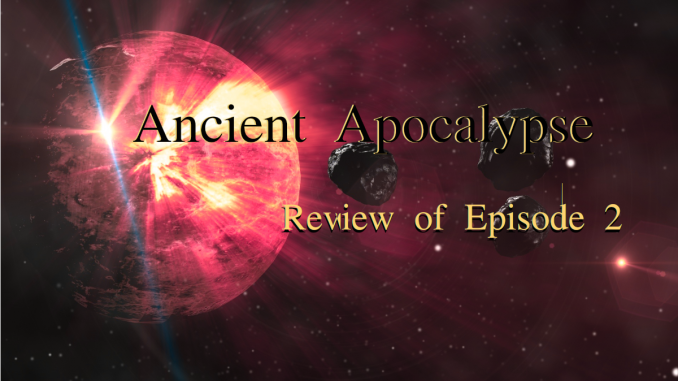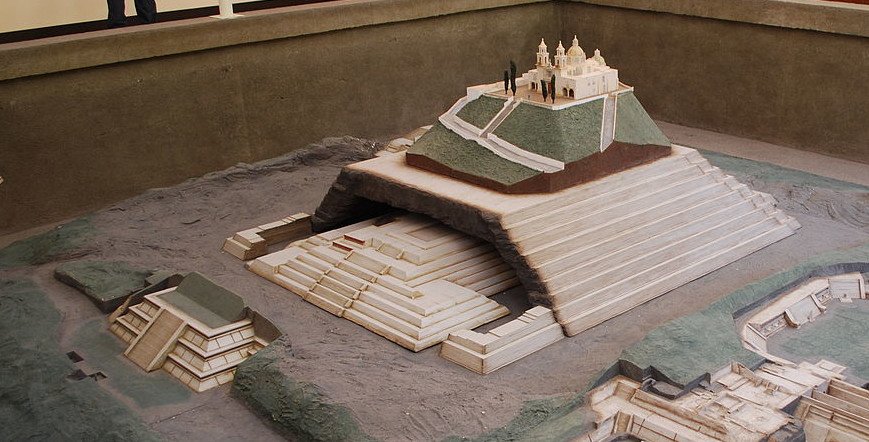
There is no mainstream in archaeology as Hancock so often says. The archaeology is either done scientifically or it isn’t. In this post, I’ll critique the second episode of Hancock’s Netflix series from the perspective of scientific archaeology.
In his introduction, Hancock says:
The notion of a lost advanced civilization of the Ice Age is extremely threatening to archaeology because it rips the ground out from that entire discipline. It removes the foundation.
Graham Hancock, Ancient Apocalypse, 00:38
Except none of that is true. I mean, I get that Hancock might see it that way, but the truth is every single archaeologist I know would be elated to discover any previously unknown civilization of the Ice Age. Or any age for that matter. Whatever their advancement is.
The reason? Mostly fame and glory! Or at the very least, some modicum of status in our community. After all, we’re people like anyone else. And new discoveries mean great publication opportunities, chances to share your work with an interested public, and to finally show your parents that your tuition wasn’t wasted!
Don’t get me wrong, a claim as extraordinary as the one Hancock makes would come with some skepticism. That’s because exceptional claims necessarily require exceptional evidence. The empirical kind. Data that can be tested and provide some degree of predictability or reproducibility.
This is why we’re careful to measure and document things to the nearest centimeter (sometimes millimeter or smaller!). We carefully brush away soil, ensuring we sift it for small artifacts. We sample layers as we slowly excavate for things like pollen, thermoluminescence samples, and phytoliths. We document the color of the soil at each level or whenever there’s a change using a standard system of comparison.
We even use dozens of tools that are non-destructive like metal detection, ground penetrating radar, magnetic resonance, magnetic susceptibility, electrical conductivity/resistivity, Lidar, and raman spectroscopy.
All to ensure we have testable, quantifiable data.
There’s no way that a “lost advanced civilization of the Ice Age” would be threatening to an archaeologist. Extremely or even mildly.
But would it rip the ground out of our entire discipline? Remove it’s foundation?
Absolutely not. The discipline is grounded in science. Sure, we’d have to write some new paragraphs, add a chapter here and there, maybe even entire textbooks. But it wouldn’t change what we already know about other civilizations. The Romans don’t suddenly disappear. The ancient Egyptians still constructed pyramids in Giza and invented a system of writing in hieroglyphs. The Aztec and the Maya still did their things.
Even if somehow Hancock was right, and each of these civilizations, existing in vastly differing places of time and space, somehow learned what they know from this alleged “advanced” civilization, they all still existed. Everything thus far discovered by archaeologists really happened. At best, we’d need to update some details, but we do this anyway. Nearly every day.
What Does Hancock Mean By “Advanced?”
Hancock never says what he means by advanced in the previous episode. Nor did he in this episode. This MacGuffin is less definable than the contents of the briefcase in Pulp Fiction. Nor does he say what it is that would define this alleged civilization. How would anyone know they found it? In fact, he really doesn’t provide a single bit of evidence that his MacGuffin is even real.
Instead he claims, “it’s a fog because there are no documents, we have to build our picture of the past from fragmentary evidence.”
Like most those that purvey pseudoscience, Hancock takes advantage of the apparent lack of empirical data that prehistory provides since it exists before documents and writing, to inject his own assumptions and ideas. The expectation seems to be that his readers and viewers will at least accept them on equal footing to the assumptions of archaeologists. After all, no one wrote these things down, so anything is possible. Right?
Cholula
This is ultimately how he approaches the site of Cholula in Mexico. There he meets with archaeologist Geoffrey McCafferty who shows him around the pyramid at Cholula, which is greater in volume than any other man-made pyramid in the world. Nearly twice the volume of the Great Pyramid in Giza, but in adobe rather than limestone blocks.
There isn’t much to critique about his visit to Cholula. The videography was good. The site is fascinating with six successive structures built over one another with the earliest construction dating to between 200 and 400 BCE. Felipe Sollis, Veronica Velaquaez, and Dionisio Rodriguez note in Cholula: la gran pirámide (2007) that pottery associated with the earliest construction level dates to around 200 BCE. Geoffrey MacCafferty say’s around 400 BCE, but it seems a vague figure.
For whatever reason, Hancock says in this episode that level “dates to about 500 BC.” But he doesn’t say what it’s based on.
The biggest complaint I have with this segment is that very little of the archaeology was shown or highlighted even though the camera shows Hancock wondering around tunnels within. Of course, he doesn’t miss his chance to compare with the “terraced pyramid” of Gunung Padang (which really isn’t a pyramid at all, rather an early punden berundak) and the Great Pyramid of Giza and its subterranean chamber.
Hancock seems to think subterranean features connect all the worlds pyramids as a common feature, but the chamber at the base of the Great Pyramid at Giza was probably the originally planned burial chamber for Khufu before it was abandoned for a chamber higher up in the structure. At any rate, it was dug, when construction began and not already present the way the spring was in Cholula.
Physical Giants vs Intellectual Giants
The real point of contention comes when Hancock shares his version of the Giants of Cholula myth then derides archaeologists for dismissing it as a source of evidence. He says something about how these might not be physical giants but “intellectual giants,” implying that the little brown people of Cholula were less intellectually capable and, dang, it’s a good thing these smart foreigners showed up to give them some “advanced culture.”
If you think that’s a bit racist, you’re right. I don’t think Hancock intends for it to be, but the result is a narrative that denies indigenous people of their own heritage and ingenuity. The myth of Xelhua, the giant architect of Cholula was one of those stories that was heavily influenced by Christian colonizers, perhaps changing an existing narrative in a syncretic way, helping mold indigenous peoples into good Christians.
There is little evidence for the existence of this story prior to the arrival of Christian colonizers who heavily influenced the Mexica people, pushing them to become Christians. And this syncretism happened over and over in Mesoamerica, particularly in Mexico. Sometimes at the hands of Christians, sometimes by willing Mexica just trying to preserve some aspects of their own cultures and religious practices.
Tell Me They’re Atlanteans Without Saying Atlantis
The last half to one-third of episode two includes Hancock interviewing Marco Vigato, author of a relatively unknown book titled, Empires of Atlantis: The Origins of Ancient Civilizations and Mystery Traditions throughout the Ages. Vigato’s work was an unoriginal and essentially racist imagining of the peopling of the world with the mythical Atlantis and a theosophical set of races being the source of all modern populations.
Armed with that set of assumptions, Vigato tells Hancock that the site of Texcotzingo (approximately 20 miles northeast of Mexico City) was “clearly reworked over a very long period of time” and was created by a civilization “much older” than the Aztec. What’s the evidence Vigato bases his bold statement of “very clearly” on, you ask?
“The rock was a very hard type of prophyry stone” and since it’s weathered…
Honestly, I got nothing. Vigato and Hancock just seemed to vote and say, “yep, the Aztec didn’t do this Atlanteans did.”
Then Vigato regales Hancock and the viewers with his version of what the feathered serpent bas relief at Xochicalco is really about. Vigato sees a global catastrophe instead of the feathered serpent that the rest of us see. And Hancock just say’s “yeah” like he just heard a good guitar riff.
GH: “Give me your interpretation of this scene, Marco.”
Vigato: “Well, you have this clearly powerful sitting figure who looks like on a raft of snakes…”
GH: “Yeah.”
Conclusion
Marco say’s “clearly” a lot and Hancock say’s “certainly” a lot more. But nothing they collude to in this segment is either clear or certain. They’re riffing a tune that is without sound if you’re expecting some sort of empirical evidence.
Like episode one, this episode ended up being a narrative told by Hancock without the advent of empirical evidence and a lot of “could it be” and “what if” suppositions. And, at no time, does Hancock define what it is he means by an “advanced civilization.”
He implies that they’re somehow better than the indigenous people of the place he happens to be. And he implies that his alleged “advanced civilization” is responsible for all the cool architecture since they either built it or taught the primitive brown people how. It’s a civilization he falls just short of calling “white” or “Atlantean,” but the presence of Vigato in this episode…
…wait. Let’s do this Graham Hancock style:
Could the presence of Marco Vigato on this episode mean that Hancock sees a proper advanced civilization as Atlantean? Could the racist undertones of Vigato’s book, with all the mentions of the various “Atlantean races” of 19th century theosophical racists mean that Hancock sees his “lost advanced civilization” as a white one?
I’m just asking questions.



Its a damned good thing that no new archeological discoveries have been made since 1750/////
I know, right? Guys like Hancock love to pick a few archaeological discoveries that fit their conclusions, but really know very little about how we arrive at our own conclusions (mostly by not starting with the conclusion the way Hancock does).
In Episode 6, graham will discover a great city that was washed away in the great flood, and now all that’s left is a wheat field with rocks. Round rocks that were bowling balls, and ball bearings for flying carpets made of t-rex skeletons, but they are now worn down, not round, with no finger holes, and the t-rex plane chassis got buried 65m years down. The proof is now in the ocean, lost to mankind, its a fantastic mystery, and archeologists just ignore it.
It’s all right to doubt Hancocks’ pseudoscience but it is also right to doubt about “articles” like this which don’t seem to know the difference between northwest and northeast.
You are so very right! Thank you for the correction. I wish I could say how it is that I arrived at northwest vs northeast, but it is decidedly the latter in both Google Earth and Wikipedia. One thing is for sure, I didn’t get the direction and distance from a memory of traveling there. In neither of the visits I made to Mexico City did I ever have the opportunity to drive out to Texcotzingo.
Thanks again, I’ll make the correction right away.